
IN THIS CHAPTER
Summary: Learn what topics are tested, how the test is scored, and basic test-taking information.

Key Ideas
![]() Most colleges will award credit for a score of 4 or 5.
Most colleges will award credit for a score of 4 or 5.
![]() Multiple-choice questions account for two-thirds of your final score.
Multiple-choice questions account for two-thirds of your final score.
![]() Free-response questions account for one-third of your final score.
Free-response questions account for one-third of your final score.
![]() Your composite score on the two test sections is converted to a score on the 1-to-5 scale.
Your composite score on the two test sections is converted to a score on the 1-to-5 scale.
The AP Economics exams that you are taking were first offered by the College Board in 1989. Since then, the number of students taking the tests has grown rapidly. In 1989, 3,198 students took the Macroeconomics exam, and by 2014 that number had increased to 117,209.
Although there might be some altruistic motivators, let’s face it: most of you take the AP Economics exams because you are seeking college credit. The majority of colleges and universities will accept a 4 or 5 as acceptable credit for their Principles of Microeconomics or Macroeconomics courses. Many private colleges will give you credit if you take both exams and receive a combined score of a 9 or 10. A small number of schools will even accept a 3 on an exam. This means you are one or two courses closer to graduation before you even begin working on the “freshman 15.” Even if you do not score high enough to earn college credit, the fact that you elected to enroll in AP courses tells admission committees that you are a high achiever and serious about your education. In recent years, close to two-thirds of students have scored a 3 or higher on the AP Macroeconomics exam.
Table 1.1 The Format of the AP Macroeconomics and Microeconomics Exams
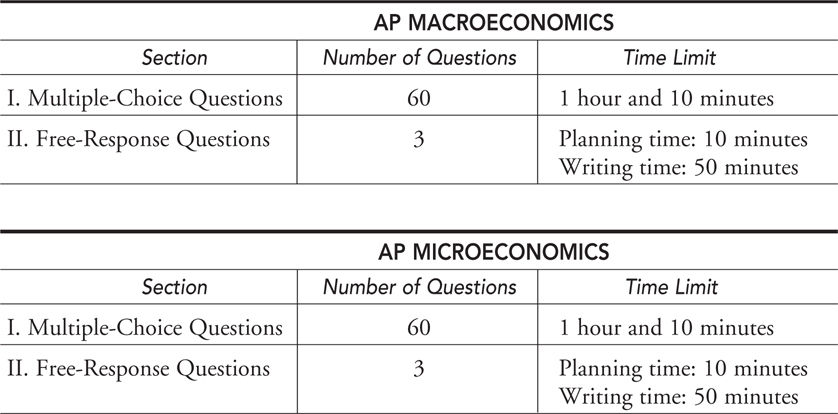
Development of each AP exam is a multiyear effort that involves many education and testing professionals and students. At the heart of the effort is the AP Macroeconomics Development Committee, a group of college and high school economics teachers who are typically asked to serve for three years. The committee and other college professors create a large pool of multiple-choice questions. With the help of the testing experts at Educational Testing Service (ETS), these questions are then pretested with college students enrolled in Principles of Microeconomics and Macroeconomics for accuracy, appropriateness, clarity, and assurance that there is only one possible answer. The results of this pretesting allow each question to be categorized by degree of difficulty. Several more months of development and refinement later, Section I of the exam is ready to be administered.
The free-response essay questions that make up Section II go through a similar process of creation, modification, pretesting, and final refinement so that the questions cover the necessary areas of material and are at an appropriate level of difficulty and clarity. The committee also makes a great effort to construct a free-response exam that allows for clear and equitable grading by the AP readers.
At the conclusion of each AP reading and scoring of exams, the exam itself and the results are thoroughly evaluated by the committee and by ETS. In this way, the College Board can use the results to make suggestions for course development in high schools and to plan future exams.
The College Board, after consulting with teachers of economics, develops a curriculum that covers material that college professors expect to cover in their first-year classes. Based upon this outline of topics, the multiple-choice exams are written such that those topics are covered in proportion to their importance to the expected economics understanding of the student. If you find this confusing, think of it this way: Suppose that faculty consultants agree that foreign currency markets are important to the Macroeconomics curriculum, maybe to the tune of 10 percent. So if 10 percent of the curriculum in your AP Macroeconomics course is devoted to foreign currency markets, you can expect roughly 10 percent of the multiple-choice exam to address this topic. Following are the general outlines for both the Microeconomics and Macroeconomics curriculum and exams. Remember, this is just a guide and each year the percentages differ slightly.
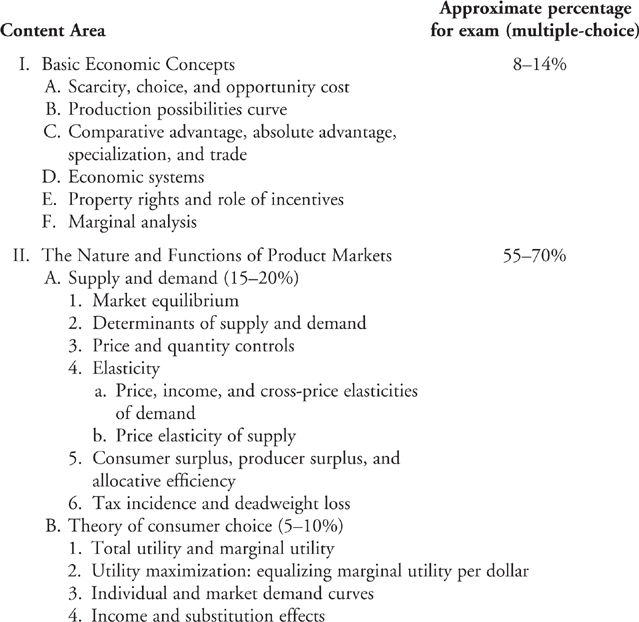
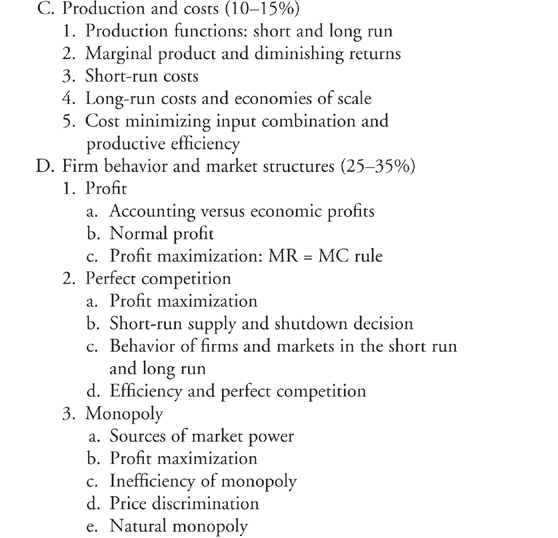
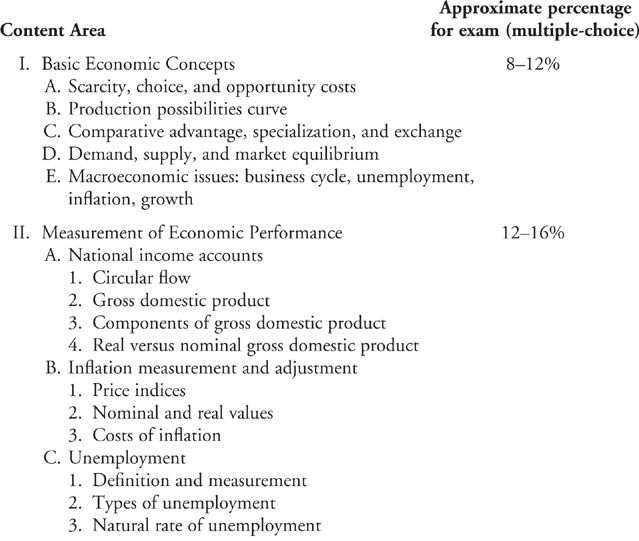
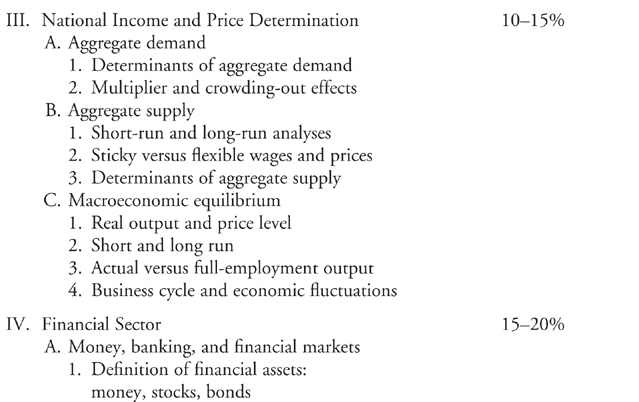
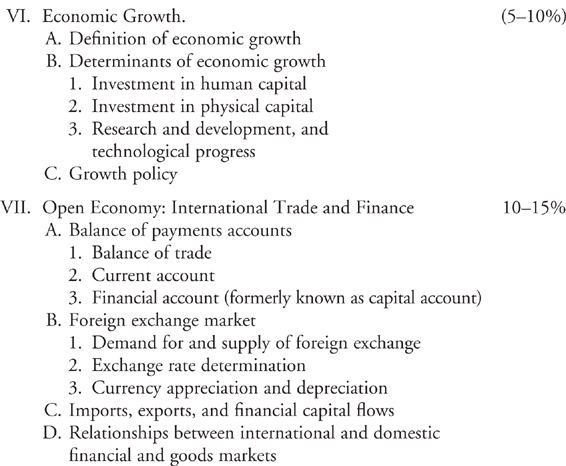
From confidential sources, I can tell you that nearly 100,000 free-response essay booklets are dropped from a three-story building, and those that fall into a small cardboard box are given a 5, those that fall into a slightly larger box are given a 4, and so on until those that fall into a dumpster receive a 1. It’s really quite scientific!
Okay, that’s not really how it’s done. Instead, every June a group of economics teachers gather for a week to assign grades to your hard work. Each of these “Faculty Consultants,” or “Readers,” spends a day or so getting trained on one question and one question only. Because each reader becomes an expert on that question, and because each exam book is anonymous, this process provides a very consistent and unbiased scoring of that question. During a typical day of grading, a random sample of each reader’s scores is selected and cross-checked by other experienced “Table Leaders” to ensure that the consistency is maintained throughout the day and the week. Each reader’s scores on a given question are also statistically analyzed to make sure that they are not giving scores that are significantly higher or lower than the mean scores given by other readers of that question. All measures are taken to maintain consistency and fairness for your benefit.
Absolutely. Even if your high school teacher happens to randomly read your booklet, there is virtually no way he or she will know it is you. To the reader, each student is a number, and to the computer, each student is a bar code.
The College Board uses some exams to help train high school teachers so that they can help the next generation of economics students to avoid common mistakes. If you check this box, you simply give permission to use your exam in this way. Even if you give permission, your anonymity is maintained.
The multiple-choice section of each Economics exam is 60 questions and is worth two-thirds of your final score. Your answer sheet is run through the computer, which adds up your correct responses. The total scores on the multiple-choice sections are based on the number of questions answered correctly. The “guessing penalty” has been eliminated, and points are no longer deducted for incorrect answers. As always, no points are awarded for unanswered questions. The formula looks something like this:
Section I Raw Score = Nright
Your performance on the free-response section is worth one-third of your final score. The exams in both microeconomics and macroeconomics consist of three questions. Because the first question is longer than the other two, and therefore scored on a higher scale, it is given a different weight in the raw score. For example, question 1 might be graded on a scale of 10 points, while question 2 is graded on a scale of 7 points and question 3 on a scale of 5 points. Every year, ETS, the Test Development Committee, and the Chief Faculty Consultant tinker with the weighting formulas. However, if you use the following sample formula as a rough guide, you’ll be able to gauge your approximate score on the practice questions.
Section II Raw Score = (1.50 × Score 1) + (1.0714 × Score 2) + (1.50 × Score 3)
With a total composite score of 90 points, and 60 being determined on Section I, the remaining 30 must be divided among the three essay questions in Section II. The total composite score is then a weighted sum of the multiple-choice and the free-response sections. In the end, when all of the numbers have been crunched, the Chief Faculty Consultant converts the range of composite scores to the 5-point scale of the AP grades.
Table 1.2 gives you a very rough example of a conversion, and as you complete the practice exam, you may use this table to give yourself a hypothetical grade, keeping in mind that every year the conversion changes slightly to adjust for the difficulty of the questions from year to year. You should receive your grade in early July.

Example:
In Section I, you receive 50 correct and 10 incorrect responses on the macroeconomics practice exam. In Section II, your scores are 7/10, 6/7, and 5/5.
Weighted Section I = 50

If you are enrolled in AP Macroeconomics in your high school, your teacher is going to provide all of these details, but a quick summary wouldn’t hurt. After all, you do not have to enroll in the AP course to register for and complete the AP exam. When in doubt, the best source of information is the College Board’s Website: www.collegeboard.com .
In 2015, the fee for taking an AP exam was $91 for each exam. Students who demonstrate financial need may receive a partial refund to help offset the cost of testing. The fee and the amount refunded to students demonstrating financial need vary from year to year, so check the College Board Website for the latest information. There are also several optional fees that can be paid if you want your scores rushed to you or if you wish to receive multiple grade reports.
The coordinator of the AP program at your school will inform you where and when you will take the exam. If you live in a small community, your exam might not be administered at your school, so be sure to get this information.
Because of budget and personnel constraints, some high schools cannot offer both Microeconomics and Macroeconomics. The majority of these schools choose the macro side of the AP program, but some choose the micro side. This puts students at a significant disadvantage when they sit down for the Microeconomics exam without having taken the course. Likewise, Macroeconomics test takers have a rough time when they have not taken the Macroeconomics course. If you are in this situation, and you put in the necessary effort, I assure you that buying this book will give you more than a fighting chance on either exam even if your school did not offer that course.

On exam day, I suggest bringing the following items:
• Several pencils and an eraser that doesn’t leave smudges.
• Black- or blue-colored pens for the free-response section. Some students like to use two colors to make their graphs stand out for the reader.
• A watch so that you can monitor your time. You never know whether the exam room will have a clock on the wall. Make sure you turn off the beep that goes off on the hour.
• Your school code.
• Your photo identification and social security number.
• Tissues.
• Your quiet confidence that you are prepared!

It’s probably a good idea to leave the following items at home:
• A calculator. It is not allowed for the Microeconomics or Macroeconomics exam. However, this does not mean that math will not be required. Questions involving simple computations have recently appeared on the exams, and later in the book I point out a few places where knowing a little math can earn you some points.
• A cell phone, smart watch, camera, tablet, laptop computer, or walkie-talkie.
• Books, a dictionary, study notes, flash cards, highlighting pens, correction fluid, a ruler, or any other office supplies.
• Portable music of any kind.
• Clothing with any economics on it.
• Panic or fear. It’s natural to be nervous, but you can comfort yourself that you have used this book well and that there is no room for fear on your exam.